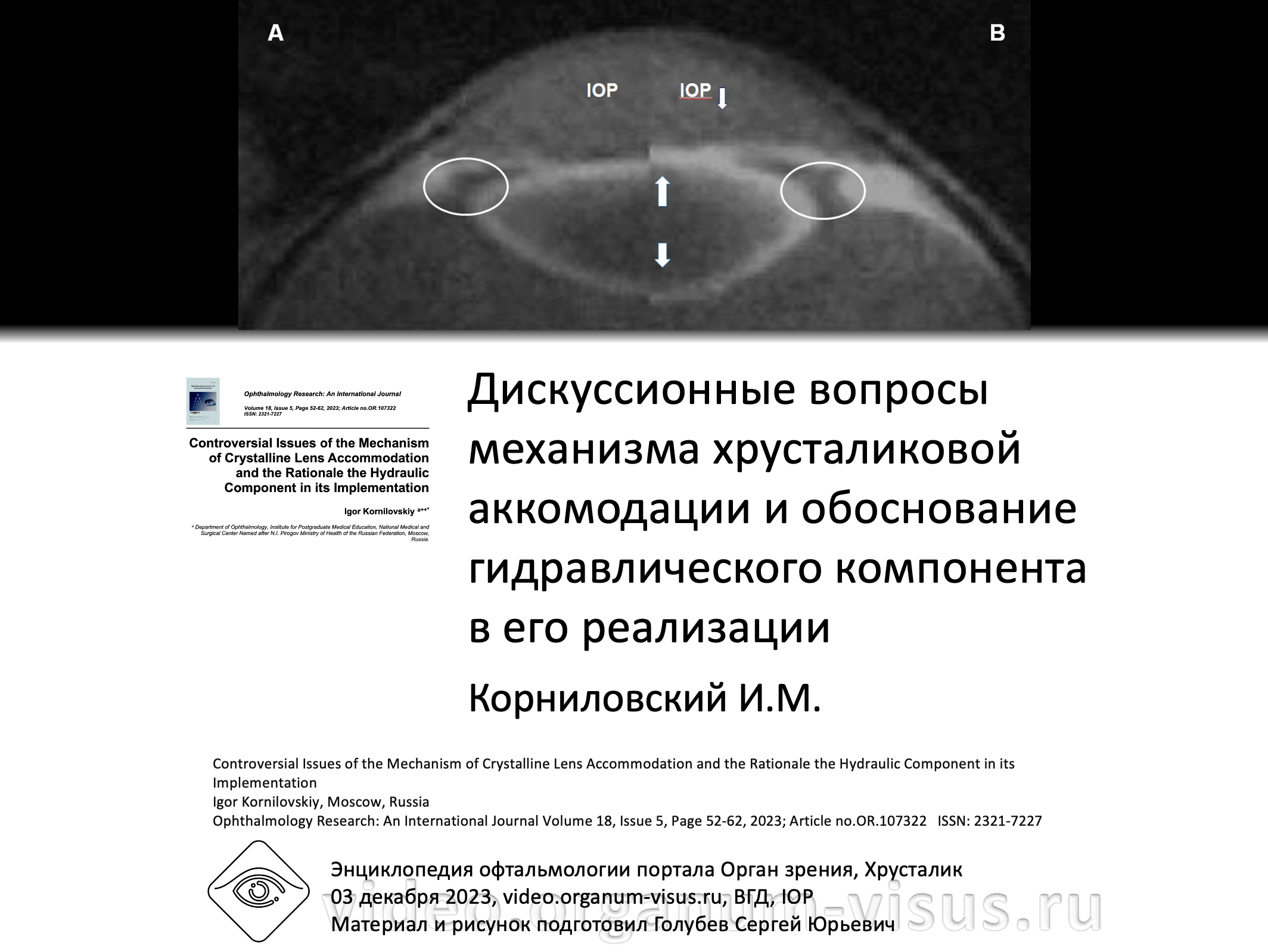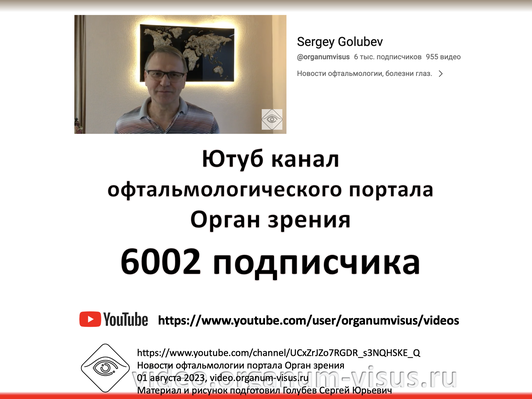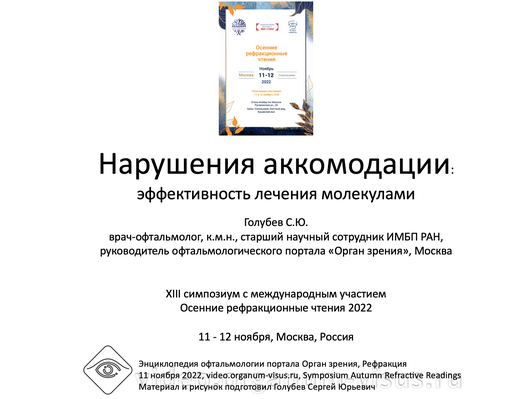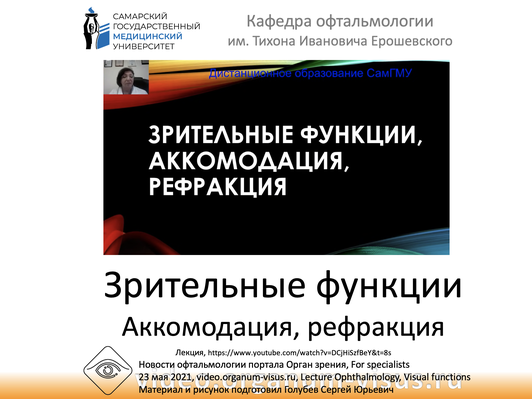Дискуссионные вопросы хрусталиковой аккомодации Корниловский И.М.
Дискуссионные вопросы хрусталиковой аккомодации Корниловский И.М. Москва Россия

Дискуссионные вопросы хрусталиковой аккомодации.
Читай статью Корниловский И.М.
Дискуссионные вопросы механизма хрусталиковой аккомодации и обоснование гидравлического компонента в его реализации.
Controversial Issues of the Mechanism of Crystalline Lens Accommodation and the Rationale the Hydraulic Component in its Implementation.
Igor Kornilovskiy, Moscow, Russia.
Ophthalmology Research: An International Journal, Volume 18, Issue 5, Page 52-62, 2023; Article no.OR.107322 ISSN: 2321-7227
journalor.com, dx.doi.org/10.9734/or
Дискуссионные вопросы механизма хрусталиковой аккомодации и обоснование гидравлического компонента в его реализации.
И.М. Корниловский
ФГБУ Национальный медико-хирургический Центр им. Н.И.Пирогова, Москва, Россия.
Реферат.
Цель.
Рассмотреть дискуссионные вопросы механизма хрусталиковой аккомодации и обосновать гидравлический компонент в его реализации.
Материалы и методы.
Проанализированы теории механизма аккомодации, и её оценка по данным ультразвуковой биомикроскопии, магнитно-резонансной томографии и оптической когерентной томографии.
Впервые были рассмотрены особенности аккомодационной активации обмена внутриглазной жидкости в закрытой гидростатической системе хрусталика с участием механочувствительных аквапоринов.
При обосновании гидравлического компонента в механизме аккомодации хрусталика особый акцент был сделан на быстрое снижение давления в передней и задней камерах глаза при сокращении меридиональной порции цилиарной мышцы.
Результаты.
Анализ различных теорий аккомодации показал, что хрусталиковый механизм её реализации до настоящего времени продолжает обсуждаться.
Впервые хрусталик был рассмотрен, как уникальная закрытая гидростатическая система, в которой уровень давления устанавливается посредством ультрафильтрации и диффузии ВГЖ с участием аквапоринов.
Аквапорины формируют ионные каналы в капсуле, клетках кубического эпителия, волокнах хрусталика и являются механочувствительными белками-рецепторами.
Открытие и закрытие ионных каналов регулирует работу калий-натриевой помпы, направленный транспорт и обмен внутриглазной жидкости в хрусталике.
Гидростатическое равновесие между давлением в хрусталике, передней и задней камерах глаза обеспечивает капсула хрусталика.
Капсулярную сумку хрусталика можно рассматривать, как изогнутой формы диафрагму, которая разделяет две гидростатических системы с различным уровнем давления. Благодаря гидростатическому буферному эффекту уровень ВГД не оказывает влияния на хрусталик, но он реагирует на быстрое его понижение.
Такое понижение давления в передней и задней камерах реализуется посредством натяжения склеральной шпоры меридиональной порцией цилиарной мышцы и срабатывания клапанного механизма склеральный синуса.
Чем больше снижение давления, тем более выпуклую форму приобретает хрусталик и усиливает свою рефракцию.
Заключение.
Наличие гидравлического компонента в механизме хрусталиковой аккомодации позволяет понять, как сокращения маленькой цилиарной мышцы может изменить форму и преломляющую силу большого хрусталика.
Ключевые слова: гидравлический компонент хрусталиковой аккомодации, склеральный синус, аквапорины, crystalline lens, vision, eyeball, ciliary muscle, hydraulic component, lens accommodation, aquaporins, scleral sinus.
Controversial Issues of the Lens Accommodation Mechanism and Substantiation of the Hydraulic Component in Its Implementation.
Igor M. Kornilovskiy.
National Medical and Surgical Center named after N.I. Pirogova, Moscow, Russia
Abstract.
Purpose.
To consider controversial issues of the mechanism of lens accommodation and to justify the hydraulic component in its implementation.
Materials and Methods.
Theories of the mechanism of accommodation and its assessment according to ultrasound biomicroscopy, magnetic resonance imaging and optical coherence tomography were analyzed.
For the first time, the features of accommodative activation of intraocular fluid exchange in the closed hydrostatic system of the lens with the participation of mechanosensitive aquaporins were considered.
When substantiating the hydraulic component in the lens accommodation mechanism, special emphasis was placed on the rapid decrease in pressure in the anterior and posterior chambers of the eye during contraction of the meridional portion of the ciliary muscle.
Results.
Analysis of various theories of accommodation has shown that the lens mechanism of its implementation continues to be discussed to this day.
For the first time, the lens was considered as a unique closed hydrostatic system in which the pressure level is established through ultrafiltration and diffusion of intraocular fluid with the participation of aquaporins. Aquaporins form ion channels in the capsule, cuboidal epithelial cells, lens fibers and are mechanosensitive receptor proteins.
The opening and closing of ion channels regulates the potassium-sodium pump, directed transport and exchange of intraocular fluid in the lens.
The hydrostatic balance between the pressure in the lens and the anterior and posterior chambers of the eye is ensured by the lens capsule.
The capsular bag of the lens can be considered as a curved diaphragm that separates two hydrostatic systems with different levels of pressure. Due to the hydrostatic buffering effect, the IOP level does not affect the lens, but it responds to a rapid decrease.
This decrease in pressure in the anterior and posterior chambers is realized through the tension of the scleral spur by the meridional portion of the ciliary muscle and the activation of the valve mechanism of the scleral sinus.
The greater the decrease in pressure, the more convex the lens takes on and increases its refraction.
Conclusion.
The presence of a hydraulic component in the mechanism of lens accommodation allows us to understand how the contraction of the small ciliary muscle can change the shape and refractive power of the large lens.
Key words: hydraulic component of lens accommodation, iridocyclolenticular complex, scleral sinus, aquaporins.
Материал для публикации на портале Орган зрения viddeo.organum-visus.ru любезно предоставил профессор Корниловский Игорь Михайлович
Читай Доклад Корниловский И.М. Новая концепция механизма аккомодации, 2013 год.
YouTube канал портала Орган зрения Sergey Golubev
YouTube канал портала Орган зрения 6002 подписчика

Нарушения аккомодации Эффективность лечения молекулами
Нарушения аккомодации Эффективность лечения молекулами Доклад Голубева С.Ю. на ОРЧ 2022

Лекция Зрительные функции Аккомодация Рефракция СамГМУ
Лекция Зрительные функции Аккомодация Рефракция Кафедра офтальмологии СамГМУ Видео
